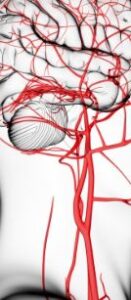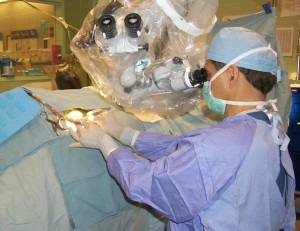Dr. Joseph Maroon Comments on New Research on Stroke Risk
 June 2023 Early this month, neurosurgeon and wellness expert, Dr. Joseph Maroon was asked to comment on recently published report on a possible stroke risk from elevated heart rate for those with severe carotid artery blockage. The research entitled, Effect of heart rate on the hemodynamics in healthy and stenosed carotid arteries, appeared in Physics of Fluids.
June 2023 Early this month, neurosurgeon and wellness expert, Dr. Joseph Maroon was asked to comment on recently published report on a possible stroke risk from elevated heart rate for those with severe carotid artery blockage. The research entitled, Effect of heart rate on the hemodynamics in healthy and stenosed carotid arteries, appeared in Physics of Fluids.
Dr. Maroon’s Comments appeared in the online journal, Healthline. The article entitled, Intense Exercise Could Raise Stroke Risk for People With Blocked Arteries, by Kaitlin Vogel, reported that the researchers, using a computer model, demonstrated that an elevated heart rate, possibility from exercise, could alter blood flow in a carotid artery that was severely stenosed or narrowed. The computer model showed the rapid pulse wave could dislodge material in a severely carotid artery to cause a stroke. They also noted that those with less severe narrowing might benefit from exercise and elevated heart rate.
Dr. Maroon responded to Healthline with the following comment:
“The authors have reported the effect of elevated heart rates on hemodynamics [how blood flows] in healthy and stenosed carotid arteries by deploying computational simulations based on physiologically relevant data. It is not a clinical study,” Dr. Joseph C. Maroon, clinical professor, vice chairman, and Heindl scholar in neuroscience at the Department of Neurosurgery at the University of Pittsburgh. The observations are of interest. They are suggesting that a 50% or greater stenotic lesion may have increased risk of flow obstruction and thus result in a stroke or heart attack,” Maroon added.
What is Carotid Artery Stenosis (Narrowing)?
Carotid artery stenosis is a narrowing of the carotid arteries, the major blood vessels that supply blood to the brain. The narrowing is caused by a buildup of plaque, a fatty substance that can clog arteries. The severity of carotid artery stenosis is measured by the percentage of narrowing. A narrowing of 50% or more is considered significant and can increase the risk of stroke. Carotid artery stenosis is often asymptomatic, meaning that people with the condition don’t have any symptoms.
However, some people may experience symptoms such as:
- Transient ischemic attack (TIA), also known as a mini-stroke, which is a temporary loss of brain function caused by a lack of blood flow
- Vision problems, such as blurry vision, double vision, or loss of vision in one eye
- Weakness or numbness on one side of the body
- Speech problems, such as difficulty speaking or understanding speech
- Dizziness
- Headache
If you experience any of these symptoms, it’s important to see a doctor right away. The treatment for carotid artery stenosis depends on the severity of the narrowing and the presence of symptoms. In some cases, no treatment may be necessary. However, if the narrowing is significant or if you have symptoms, your doctor may recommend one or more of the following treatments:
- Medication to lower cholesterol and blood pressure
- Lifestyle changes such as quitting smoking, eating a healthy diet, and exercising regularly
- Surgery to remove plaque from the artery (carotid endarterectomy) or to insert a stent (a tube-shaped device) to keep the artery open (carotid artery stenting)
Carotid artery stenosis is a serious condition, but it can be treated and managed. If you have been diagnosed with carotid artery stenosis, it’s important to work with your doctor to develop a treatment plan that’s right for you.
REF: Physics of Fluids 35, 061906 (2023), https://doi.org/10.1063/5.0153323




 Dr. Maroon received an athletic scholarship to Indiana University in Bloomington, Indiana where as an undergraduate, he was named a Scholastic All-American in football. Dr. Maroon has successfully maintained his personal athletic interests through participation in 9 marathons and more than 72 Olympic-distance triathlon events. However, his greatest athletic accomplishment is his participation in 8 Ironman triathlons (Hawaii – 1993, 2003, 2008, 2010, 2013; Canada – 1995; New Zealand – 1997; Germany – 2000), where he usually finishes in the top 10 of his age group. Recently, in July 2012 and 2013, he finished second and third, respectively, in his age group in the Muncie, Indiana half Ironman triathlon. In October 2013 he completed his 5th World Championship Ironman in Kona, Hawaii.
Dr. Maroon received an athletic scholarship to Indiana University in Bloomington, Indiana where as an undergraduate, he was named a Scholastic All-American in football. Dr. Maroon has successfully maintained his personal athletic interests through participation in 9 marathons and more than 72 Olympic-distance triathlon events. However, his greatest athletic accomplishment is his participation in 8 Ironman triathlons (Hawaii – 1993, 2003, 2008, 2010, 2013; Canada – 1995; New Zealand – 1997; Germany – 2000), where he usually finishes in the top 10 of his age group. Recently, in July 2012 and 2013, he finished second and third, respectively, in his age group in the Muncie, Indiana half Ironman triathlon. In October 2013 he completed his 5th World Championship Ironman in Kona, Hawaii.